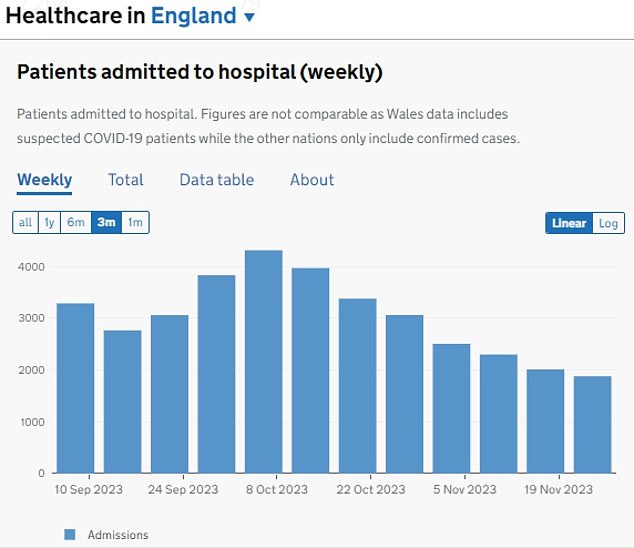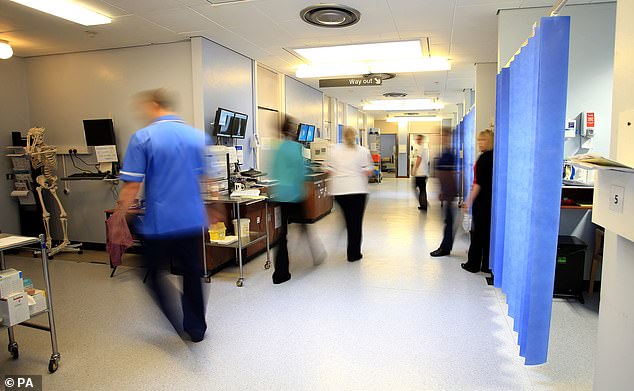What is JN.1? Explosive new Covid variant is taking off in Britain amid fears of impending wave which will cause carnage in NHS hospitals already juggling winter woes of norovirus, flu and ‘100-day cough’
Another new Covid variant is beginning to sweep Britain, sparking fears of a new wave just as winter pressure on ailing hospitals increases.
Officials claim that JN.1 vastly outperforms all other known strains.
Last month it was one in 13 cases in England, but the true picture is now likely to be even higher, even if overall cases remain low.
The heads of the UK Health Security Agency (UKHSA) are now formally monitoring the variant – although that doesn't mean they consider it a threat.
Leading infectious disease experts emphasize that the chance of a new variant emerging that threatens to send the world back to square one is small.
The threat of Covid has been drastically blunted by a wall of immunity built up by vaccines and repeated waves.
The graph shows the Covid lineage observed in Britain between June and November this year. JN.1 was behind 7.9 percent of cases last month (shown in chart). It is a spin-off of BA.2.86, known as Pirola

The number of Covid cases in England remained the same at the end of November. Data shows that about 500 people tested positive per day. However, because few people are being tested for the virus, the actual toll will be much higher
As such, it typically causes an illness similar to the flu today, unlike the alarming illness that burst onto the scene in early 2020.
Despite the darkest days of the pandemic being consigned to history, Britain is still vulnerable to Covid waves sickening hundreds of thousands of people at once.
A potential rise in cases would cause carnage in the NHS, which is already seeing a surge from a triple whammy of norovirus, flu and RSV.
Whooping cough cases are also increasing, data suggests.
Health chiefs have warned that the viruses will continue to spread in the coming weeks.
Professor Julian Redhead, NHS England national clinical director for emergency care, said numbers of all seasonal insects were 'rising'.
He added: 'Demand for hospitals and staff remains high.
“And as we experience more and more bouts of cold weather and people gather indoors for festive events and end-of-year celebrations, we expect to see a continued increase in the spread of winter viruses in the community.”
This will lead to hospital admissions in some cases, Professor Redhead warned.
JN.1 was first spotted by the UKHSA as part of a routine program designed to assess emerging infections.
It was flagged because of a troublesome mutation in the spike protein, a protein known to help the virus evade the body's immune system.
UKHSA leaders noted that the specific tension was also escalating internationally and in Britain.
JN.1 has now been designated as an official variant and named it V-23DEC-01 for official purposes. The process means that it is followed formally.
As of Monday, 302 Covid cases in Britain have been caused by JN.1, the vast majority (223) of which were in England. But this will be a huge underestimate, because only a fraction of sick patients are now tested.
By mid-November it was responsible for 7.9 per cent of cases in England.
Dr. Meaghan Kall, an epidemiologist at the UKHSA, said JN.1 has a weekly estimated growth advantage of 84.2 percent.
This means the variant is taking off faster than any other strain seen in at least eight months, she said.
Dr. Kall wrote on
UKHSA bosses'however, are not completely in the dark about this variant, thanks to their assessments of the ancestral species.
NHS data released today shows that an average of 234 flu patients were in hospital per day last week, an increase of 53 per cent in just one week.
Cases of the winter vomiting virus norovirus are also increasing, with 406 cases per day, an increase of 15 percent in a week.
In addition, norovirus cases led to an average of 92 beds being closed per day to prevent the highly contagious disease, which causes vomiting and diarrhea, from spreading to other patients.
Cases of respiratory syncytial virus (RSV) have also risen by 11 percent among children in a week, with 146 children in hospital every day.

According to official figures, around 2,000 Covid patients were admitted to hospitals per day in November

The NHS said it has plans to cope with the increasing pressures, including additional ambulances and beds, as well as the expansion of 'virtual wards' – with some patients being monitored and treated from home.
Separate UKHSA data shows that suspected cases of whooping cough, also known as 100-day cough because of how long symptoms can last, are increasing.
About 716 people were believed to have fallen ill with the bacterial infection of the lungs between July and the end of November – more than three times as many as the 217 reported over the same period in 2022, the figures show.
A whooping cough vaccine is offered to babies as part of the routine NHS vaccination and to pregnant women, who are at higher risk of serious illness.
Dr. Gayatri Amirthalingam, epidemiologist at the UKHSA, said: 'Before the introduction of routine immunisation, whooping cough affected tens of thousands of people.
'Thanks to vaccination, this has fallen dramatically, but the infection has not yet disappeared completely, because neither infection nor vaccination can provide lifelong protection.
'Social distancing and lockdown measures imposed across Britain during the Covid pandemic had a significant impact on the spread of infections, including whooping cough.
'As expected, we are now seeing cases of whooping cough rise again, so it is vital that pregnant women ensure they get vaccinated to protect their babies.'
The NHS said it has plans to cope with the increasing pressures, including additional ambulances and beds, as well as the expansion of 'virtual wards' – with some patients being monitored and treated from home.
Health chiefs also urged those eligible to get their flu and Covid booster jabs to reduce the risk of becoming seriously ill and needing hospital care.
They urged Britons to turn to pharmacies and local urgent treatment centers where necessary, as the rising number of virus patients continues to worsen emergency department delays.
The healthcare sector is also facing the latest round of strikes announced by trainee doctors, who are to strike for three days from 7am on December 20 in a bid for a higher pay rise.
The British Medical Association, which is coordinating the campaign, has rejected an additional three percent pay rise, on top of the 8.8 percent increase already granted for this year. The union has called for a 35 percent increase.
